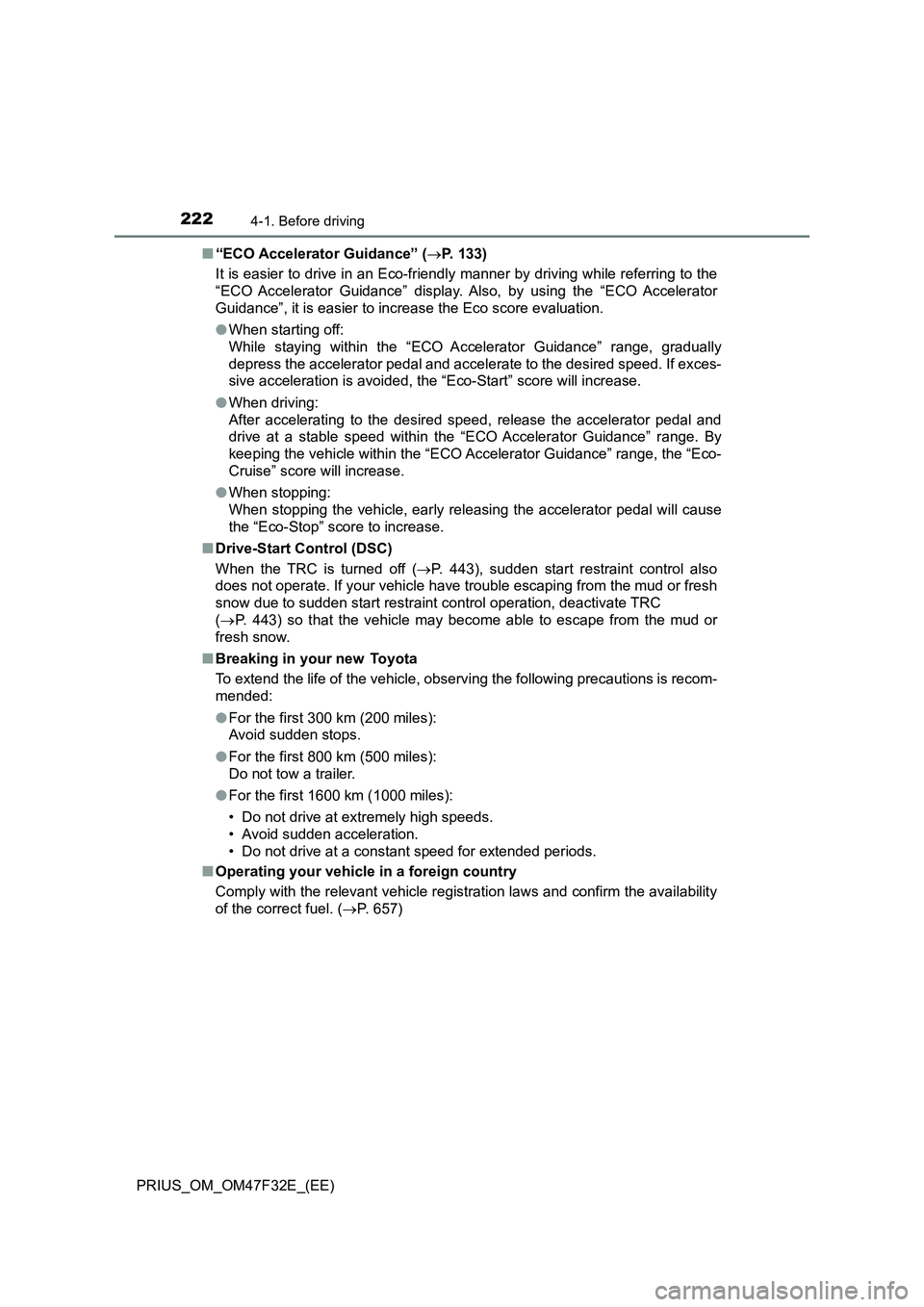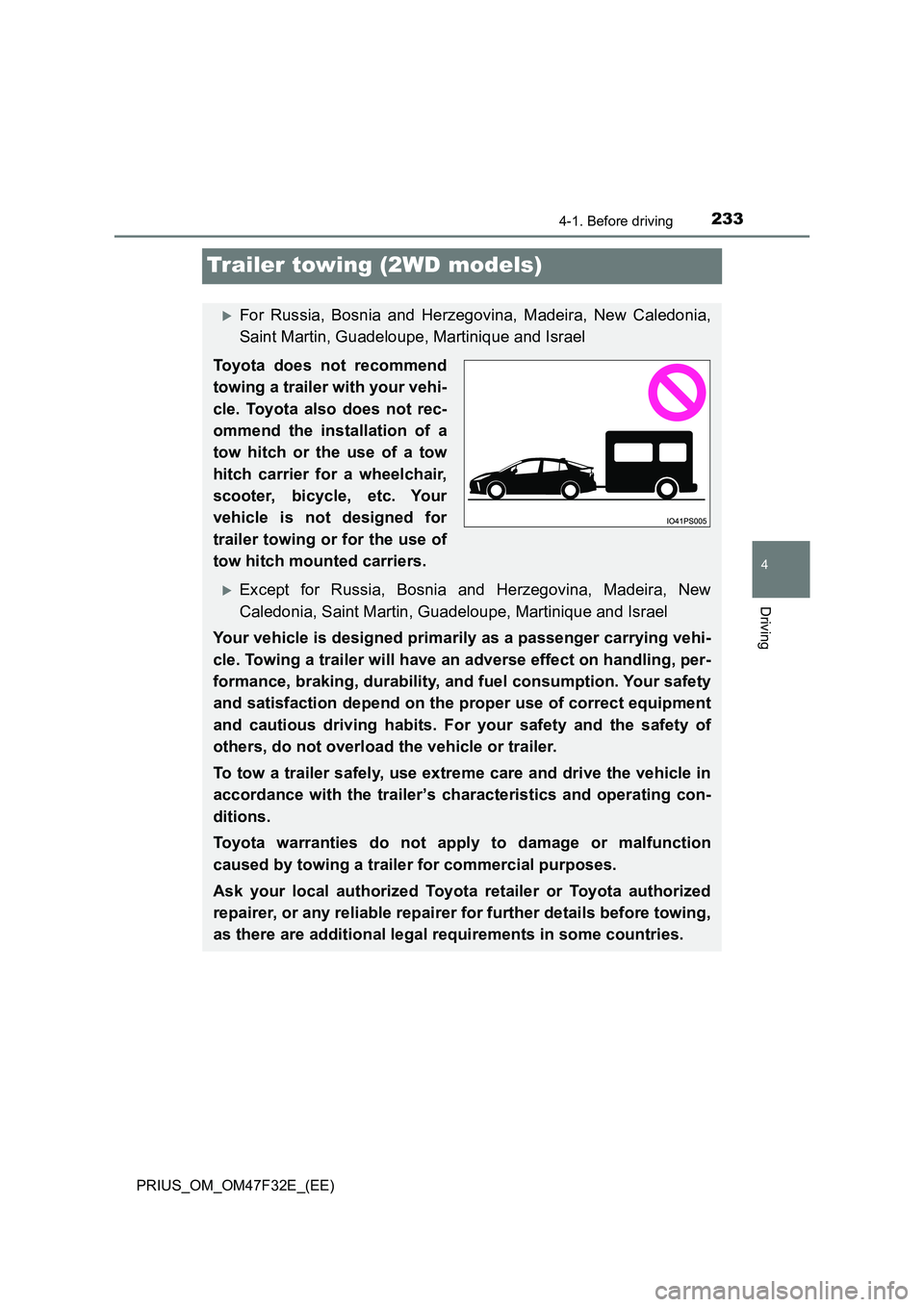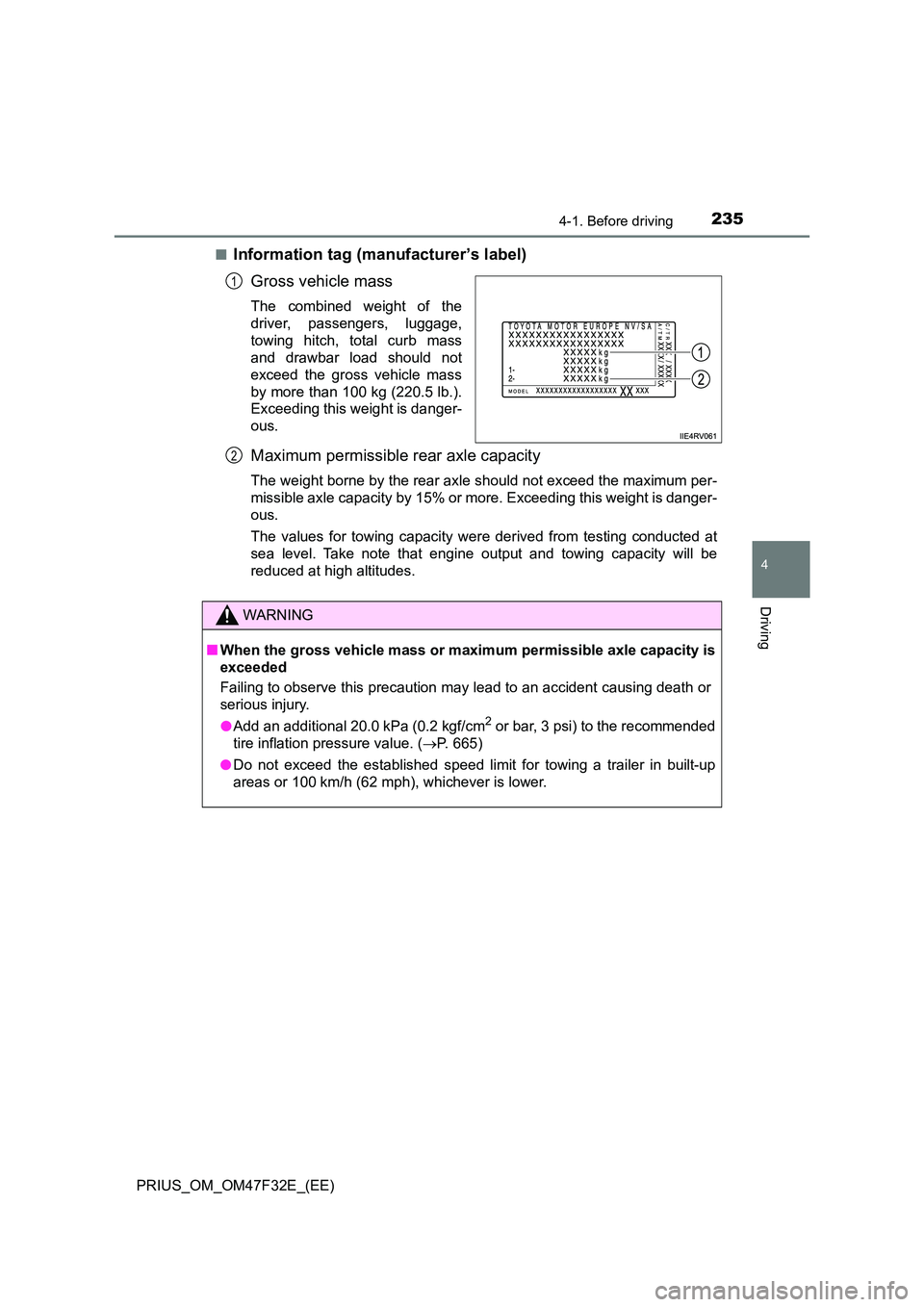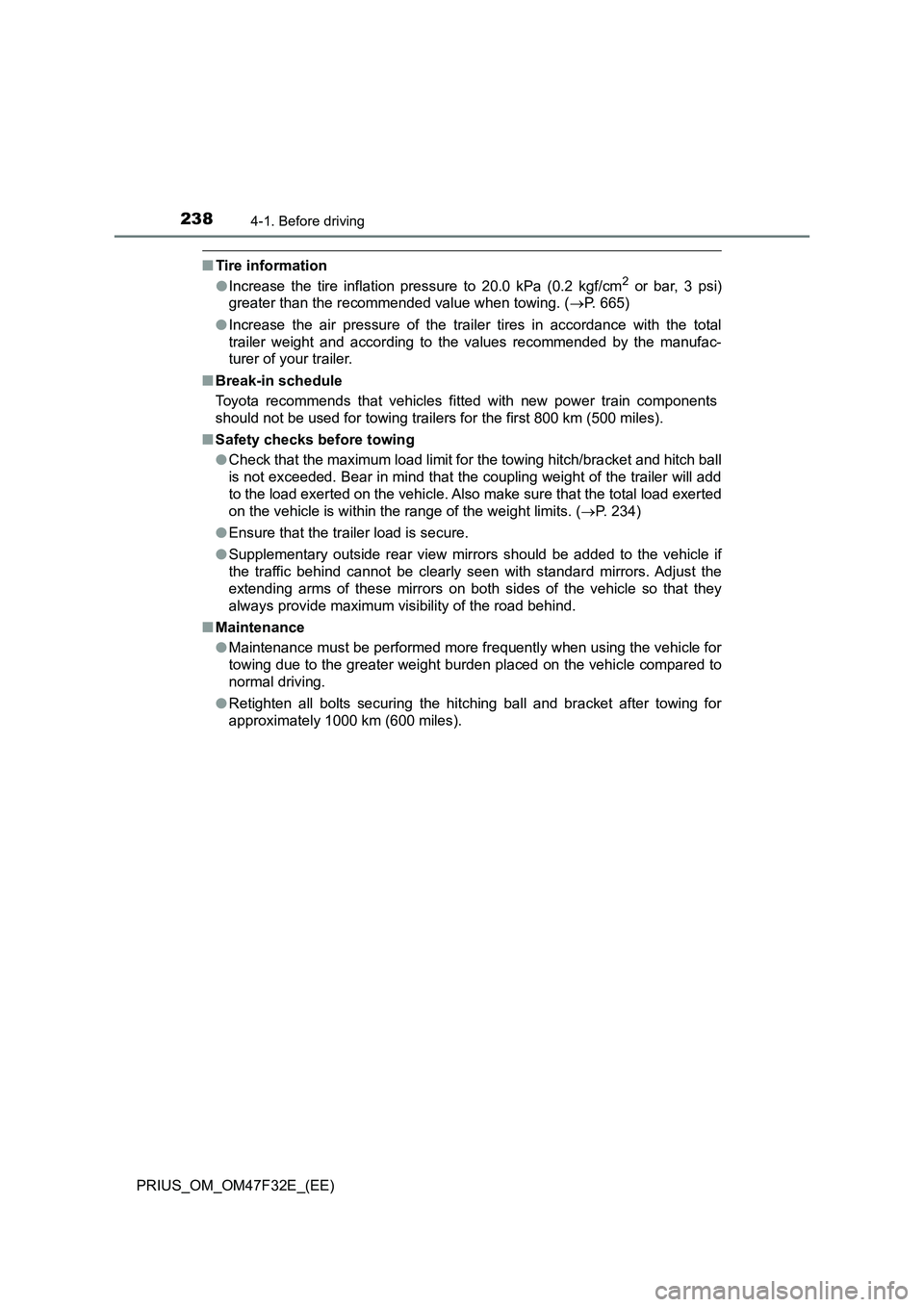2023 TOYOTA PRIUS trailer
[x] Cancel search: trailerPage 5 of 770

3
1
8
7
6
5
4
3
2
PRIUS_OM_OM47F32E_(EE)
4-1. Before driving
Driving the vehicle .............220
Cargo and luggage ............231
Trailer towing
(2WD models)..................233
Trailer towing
(AWD models) .................243
4-2. Driving procedures
Power (ignition) switch .......244
EV drive mode ...................250
Hybrid transmission ...........253
Turn signal lever ................259
Parking brake.....................260
4-3. Operating the lights
and wipers
Headlight switch.................261
AHB (Automatic High
Beam) ..............................266
Fog light switch ..................270
Windshield wipers and
washer .............................271
Rear window wiper and
washer .............................275
4-4. Refueling
Opening the fuel tank
cap ...................................277
4-5. Using the driving
support systems
Toyota Safety Sense ......... 282
PCS (Pre-Collision
System) ........................... 296
LTA
(Lane Tracing Assist) ...... 307
RSA (Road Sign Assist) .... 323
Dynamic radar cruise
control with full-speed
range ............................... 329
Cruise control .................... 346
Driving mode select
switch .............................. 351
Speed limiter ..................... 353
BSM
(Blind Spot Monitor) ........ 356
• The Blind Spot Monitor
function ......................... 372
• The Rear Crossing
Traffic Alert function ...... 375
Toyota parking
assist-sensor ................... 381
Parking Support Brake
function ........................... 394
S-IPA (Simple Intelligent
Parking Assist
System) ........................... 405
GPF (Gasoline Particulate
Filter) system .................. 440
Driving assist systems....... 441
4-6. Driving tips
Hybrid vehicle driving
tips .................................. 449
Winter driving tips.............. 452
4Driving
Page 221 of 770

219
4Driving
PRIUS_OM_OM47F32E_(EE)4-1. Before driving
Driving the vehicle ............. 220
Cargo and luggage ............ 231
Trailer towing
(2WD models).................. 233
Trailer towing
(AWD models) ................. 243
4-2. Driving procedures
Power (ignition) switch ....... 244
EV drive mode ................... 250
Hybrid transmission ........... 253
Turn signal lever ................ 259
Parking brake .................... 260
4-3. Operating the lights
and wipers
Headlight switch ................ 261
AHB (Automatic High
Beam) .............................. 266
Fog light switch .................. 270
Windshield wipers and
washer ............................. 271
Rear window wiper and
washer ............................. 275
4-4. Refueling
Opening the fuel tank
cap ................................... 2774-5. Using the driving
support systems
Toyota Safety Sense ......... 282
PCS (Pre-Collision
System) ........................... 296
LTA
(Lane Tracing Assist)....... 307
RSA (Road Sign Assist)..... 323
Dynamic radar cruise
control with full-speed
range ............................... 329
Cruise control..................... 346
Driving mode select
switch............................... 351
Speed limiter ...................... 353
BSM
(Blind Spot Monitor) ......... 356
• The Blind Spot Monitor
function .......................... 372
• The Rear Crossing
Traffic Alert function ...... 375
Toyota parking
assist-sensor ................... 381
Parking Support Brake
function ............................ 394
S-IPA (Simple Intelligent
Parking Assist
System) ........................... 405
GPF (Gasoline Particulate
Filter) system ................... 440
Driving assist systems ....... 441
4-6. Driving tips
Hybrid vehicle driving
tips ................................... 449
Winter driving tips .............. 452
Page 224 of 770

2224-1. Before driving
PRIUS_OM_OM47F32E_(EE)■“ECO Accelerator Guidance” (P. 133)
It is easier to drive in an Eco-friendly manner by driving while referring to the
“ECO Accelerator Guidance” display. Also, by using the “ECO Accelerator
Guidance”, it is easier to increase the Eco score evaluation.
●When starting off:
While staying within the “ECO Accelerator Guidance” range, gradually
depress the accelerator pedal and accelerate to the desired speed. If exces-
sive acceleration is avoided, the “Eco-Start” score will increase.
●When driving:
After accelerating to the desired speed, release the accelerator pedal and
drive at a stable speed within the “ECO Accelerator Guidance” range. By
keeping the vehicle within the “ECO Accelerator Guidance” range, the “Eco-
Cruise” score will increase.
●When stopping:
When stopping the vehicle, early releasing the accelerator pedal will cause
the “Eco-Stop” score to increase.
■Drive-Start Control (DSC)
When the TRC is turned off (P. 443), sudden start restraint control also
does not operate. If your vehicle have trouble escaping from the mud or fresh
snow due to sudden start restraint control operation, deactivate TRC
(P. 443) so that the vehicle may become able to escape from the mud or
fresh snow.
■Breaking in your new Toyota
To extend the life of the vehicle, observing the following precautions is recom-
mended:
●For the first 300 km (200 miles):
Avoid sudden stops.
●For the first 800 km (500 miles):
Do not tow a trailer.
●For the first 1600 km (1000 miles):
• Do not drive at extremely high speeds.
• Avoid sudden acceleration.
• Do not drive at a constant speed for extended periods.
■Operating your vehicle in a foreign country
Comply with the relevant vehicle registration laws and confirm the availability
of the correct fuel. (P. 657)
Page 235 of 770

233
4
4-1. Before driving
Driving
PRIUS_OM_OM47F32E_(EE)
Trailer towing (2WD models)
For Russia, Bosnia and Herzegovina, Madeira, New Caledonia,
Saint Martin, Guadeloupe, Martinique and Israel
Toyota does not recommend
towing a trailer with your vehi-
cle. Toyota also does not rec-
ommend the installation of a
tow hitch or the use of a tow
hitch carrier for a wheelchair,
scooter, bicycle, etc. Your
vehicle is not designed for
trailer towing or for the use of
tow hitch mounted carriers.
Except for Russia, Bosnia and Herzegovina, Madeira, New
Caledonia, Saint Martin, Guadeloupe, Martinique and Israel
Your vehicle is designed primarily as a passenger carrying vehi-
cle. Towing a trailer will have an adverse effect on handling, per-
formance, braking, durability, and fuel consumption. Your safety
and satisfaction depend on the proper use of correct equipment
and cautious driving habits. For your safety and the safety of
others, do not overload the vehicle or trailer.
To tow a trailer safely, use extreme care and drive the vehicle in
accordance with the trailer’s characteristics and operating con-
ditions.
Toyota warranties do not apply to damage or malfunction
caused by towing a trailer for commercial purposes.
Ask your local authorized Toyota retailer or Toyota authorized
repairer, or any reliable repairer for further details before towing,
as there are additional legal requirements in some countries.
Page 236 of 770

2344-1. Before driving
PRIUS_OM_OM47F32E_(EE)
◆Weight limits
Check the allowable towing capacity, GVM (Gross Vehicle Mass),
MPAC (Maximum Permissible Axle Capacity), and permissible
drawbar load before towing. (P. 654)
◆Towing hitch/bracket
Toyota recommends the use of the Toyota hitch/bracket for your
vehicle. Other products of a suitable nature and comparable quality
may also be used.
For vehicles where the towing device blocks any of the lights or
license plate, the following shall be observed:
●Do not use towing devices that cannot be easily removed or
repositioned.
●Towing devices must be removed or repositioned when not in
use.
Please consult at any authorized dealer or repairer, or another duly
qualified and equipped professional when installing trailer lights, as
incorrect installation may cause damage to the vehicle’s lights. Please
take care to comply with your state’s laws when installing trailer lights.
■Total trailer weight and permissible drawbar load
Total trailer weight
Weight of the trailer itself plus
the trailer load should be within
the maximum towing capacity.
Exceeding this weight is danger-
ous. (P. 654)
When towing a trailer, use a fric-
tion coupler or friction stabilizer
(sway control device).
Permissible drawbar load
Allocate the trailer load so that the drawbar load is greater than 25 kg
(55.1 lb.) or 4% of the towing capacity. Do not let the drawbar load
exceed the indicated weight. (P. 654)
Connecting trailer lights
Important points regarding trailer loads
1
2
Page 237 of 770

2354-1. Before driving
4
Driving
PRIUS_OM_OM47F32E_(EE)
■Information tag (manufacturer’s label)
Gross vehicle mass
The combined weight of the
driver, passengers, luggage,
towing hitch, total curb mass
and drawbar load should not
exceed the gross vehicle mass
by more than 100 kg (220.5 lb.).
Exceeding this weight is danger-
ous.
Maximum permissible rear axle capacity
The weight borne by the rear axle should not exceed the maximum per-
missible axle capacity by 15% or more. Exceeding this weight is danger-
ous.
The values for towing capacity were derived from testing conducted at
sea level. Take note that engine output and towing capacity will be
reduced at high altitudes.
1
2
WARNING
■ When the gross vehicle mass or maximum permissible axle capacity is
exceeded
Failing to observe this precaution may lead to an accident causing death or
serious injury.
● Add an additional 20.0 kPa (0.2 kgf/cm2 or bar, 3 psi) to the recommended
tire inflation pressure value. ( P. 665)
● Do not exceed the established speed limit for towing a trailer in built-up
areas or 100 km/h (62 mph), whichever is lower.
Page 240 of 770

2384-1. Before driving
PRIUS_OM_OM47F32E_(EE)
■Tire information
●Increase the tire inflation pressure to 20.0 kPa (0.2 kgf/cm2 or bar, 3 psi)
greater than the recommended value when towing. (P. 665)
●Increase the air pressure of the trailer tires in accordance with the total
trailer weight and according to the values recommended by the manufac-
turer of your trailer.
■Break-in schedule
Toyota recommends that vehicles fitted with new power train components
should not be used for towing trailers for the first 800 km (500 miles).
■Safety checks before towing
●Check that the maximum load limit for the towing hitch/bracket and hitch ball
is not exceeded. Bear in mind that the coupling weight of the trailer will add
to the load exerted on the vehicle. Also make sure that the total load exerted
on the vehicle is within the range of the weight limits. (P. 234)
●Ensure that the trailer load is secure.
●Supplementary outside rear view mirrors should be added to the vehicle if
the traffic behind cannot be clearly seen with standard mirrors. Adjust the
extending arms of these mirrors on both sides of the vehicle so that they
always provide maximum visibility of the road behind.
■Maintenance
●Maintenance must be performed more frequently when using the vehicle for
towing due to the greater weight burden placed on the vehicle compared to
normal driving.
●Retighten all bolts securing the hitching ball and bracket after towing for
approximately 1000 km (600 miles).
Page 241 of 770

2394-1. Before driving
4
Driving
PRIUS_OM_OM47F32E_(EE)
Your vehicle will handle differently when towing a trailer. In order to
avoid accident, death or serious injury, keep the following in mind
when towing:
■Checking connections between trailer and lights
Stop the vehicle and check the operation of the connection between
the trailer and lights after driving for a brief period as well as before
starting off.
■Practicing driving with a coupled trailer
● Get the feel for turning, stopping and reversing with the trailer
coupled by practicing in an area with no or light traffic.
● When reversing with a coupled trailer, hold the section of the
steering wheel nearest to you and rotate clockwise to turn the
trailer left or counterclockwise to turn it right. Always rotate a little
at a time to prevent steering error. Have someone guide you
when reversing to lessen the risk of an accident.
■Increasing vehicle-to-vehicle distance
At a speed of 10 km/h (6 mph), the distance to the vehicle running
ahead of you should be equivalent to or greater than the combined
length of your vehicle and trailer. Avoid sudden braking that may
cause skidding. Otherwise, the vehicle may spin out of control. This
is especially true when driving on wet or slippery road surfaces.
NOTICE
■ When the rear bumper strengthening material is aluminum
Ensure the steel bracket part does not come directly in contact with that
area.
When steel and aluminum come into contact, there is a reaction similar to
corrosion, which will weaken the section concerned and may result in dam-
age. Apply a rust inhibitor to parts that will come in contact when attaching a
steel bracket.
Guidance